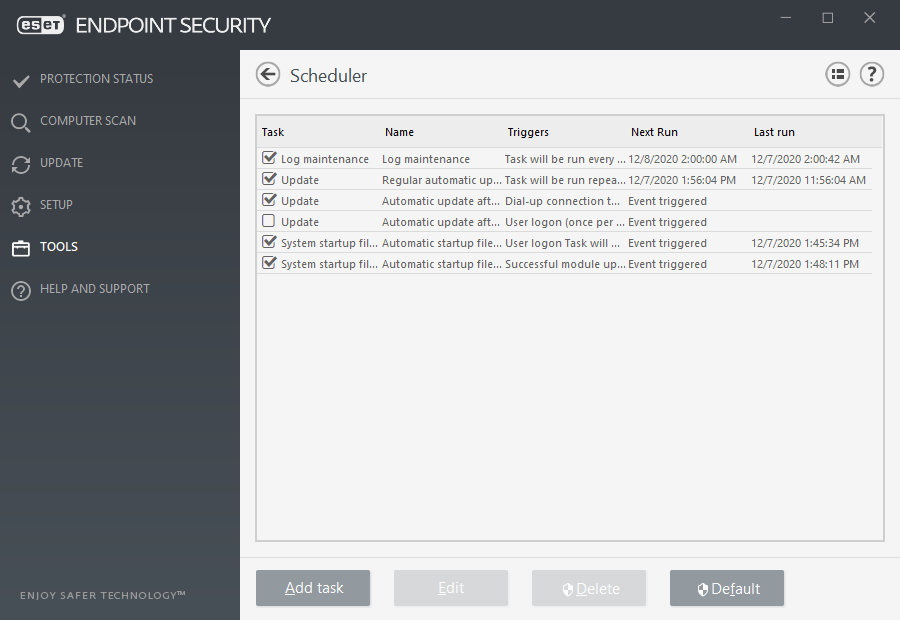Scheduler
the Scheduler manages and launches scheduled tasks with predefined configuration and properties.
The Scheduler can be accessed from the ESET Endpoint Security main program window by clicking Tools > Scheduler. The Scheduler contains a list of all scheduled tasks and configuration properties such as the predefined date, time, and scanning profile used.
The Scheduler serves to schedule the following tasks: detection engine update, scanning task, system startup file check and log maintenance. You can add or delete tasks directly from the main Scheduler window (click Add task or Delete at the bottom). Right click anywhere in the Scheduler window to perform the following actions: display detailed information, perform the task immediately, add a new task, and delete an existing task. Use the check boxes at the beginning of each entry to activate/deactivate the tasks.
By default, the following scheduled tasks are displayed in Scheduler:
•Log maintenance
•Regular automatic update
•Automatic update after dial-up connection
•Automatic update after user logon
•Automatic startup file check (after user logon)
•Automatic startup file check (after successful module update)
To edit the configuration of an existing scheduled task (both default and user-defined), right-click the task and click Edit or select the task you wish to modify and click the Edit button.

Add a new task
1.Click Add task at the bottom of the window.
2.Enter the name of the task.
3.Select the desired task from the drop-down menu:
•Run external application – Schedules the execution of an external application.
•Log maintenance – Log files also contain leftovers from deleted records. This task optimizes records in log files on a regular basis to work effectively.
•System startup file check – Checks files that are allowed to run at system startup or logon.
•Create a computer status snapshot – Creates an ESET SysInspector computer snapshot – gathers detailed information about system components (for example, drivers, applications) and assesses the risk level of each component.
•On-demand computer scan – Performs a computer scan of files and folders on your computer.
•Update – Schedules an Update task by updating the detection engine and program modules.
4.Turn on the Enabled switch if you want to activate the task (you can do this later by selecting/deselecting the check box in the list of scheduled tasks), click Next and select one of the timing options:
•Once – The task will be performed at the predefined date and time.
•Repeatedly – The task will be performed at the specified time interval.
•Daily – The task will run repeatedly each day at the specified time.
•Weekly – The task will be run on the selected day and time.
•Event triggered – The task will be performed on a specified event.
5.Select Skip task when running on battery power to minimize system resources while a laptop is running on battery power. The task will be run on the specified date and time in Task execution fields. If the task could not be run at the predefined time, you can specify when it will be performed again:
•At the next scheduled time
•As soon as possible
•Immediately, if the time since the last run exceeds a specified value (the interval can be defined using the Time since last run scroll box)
You can review scheduled task when right click and click Show task details.

